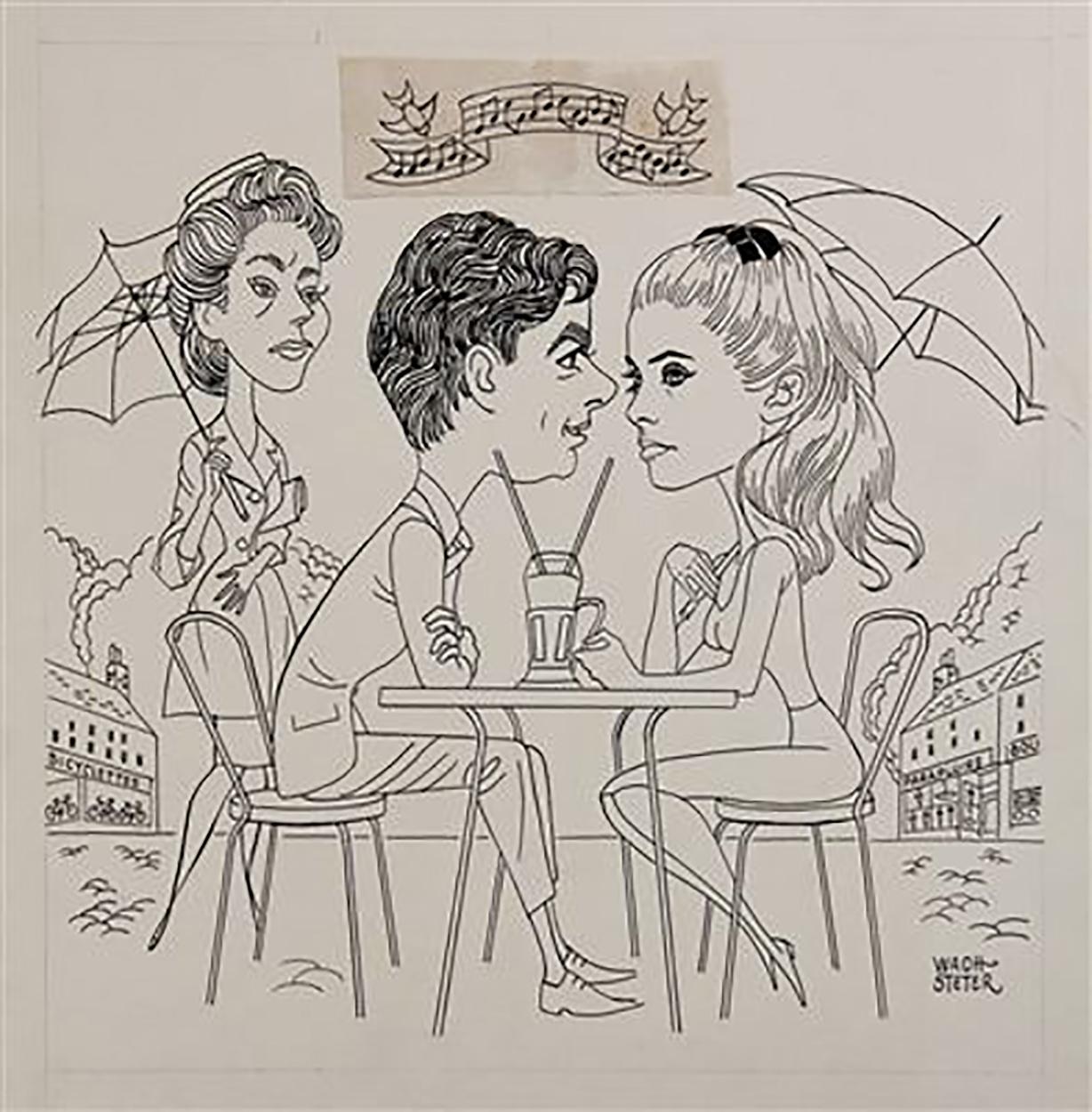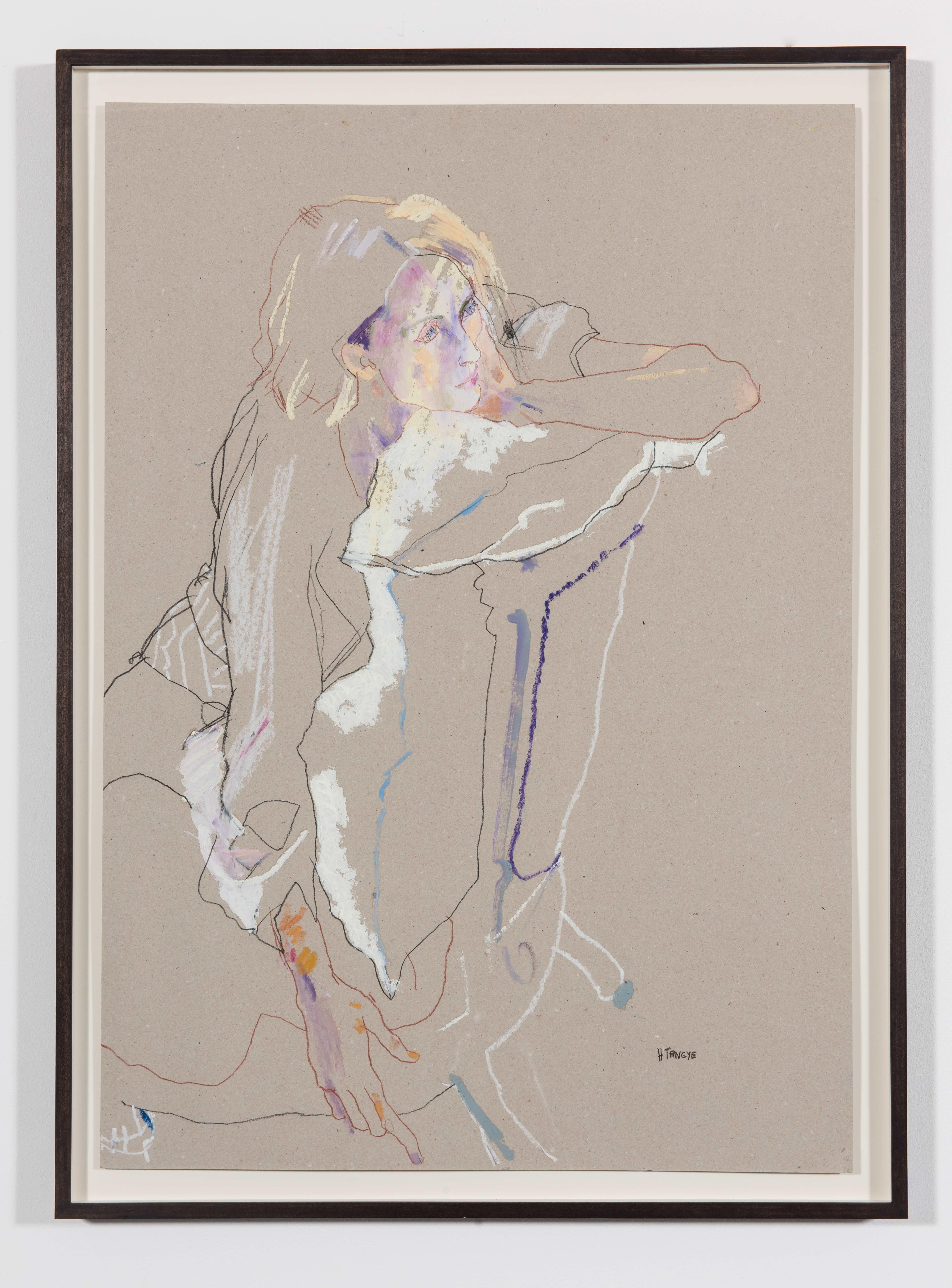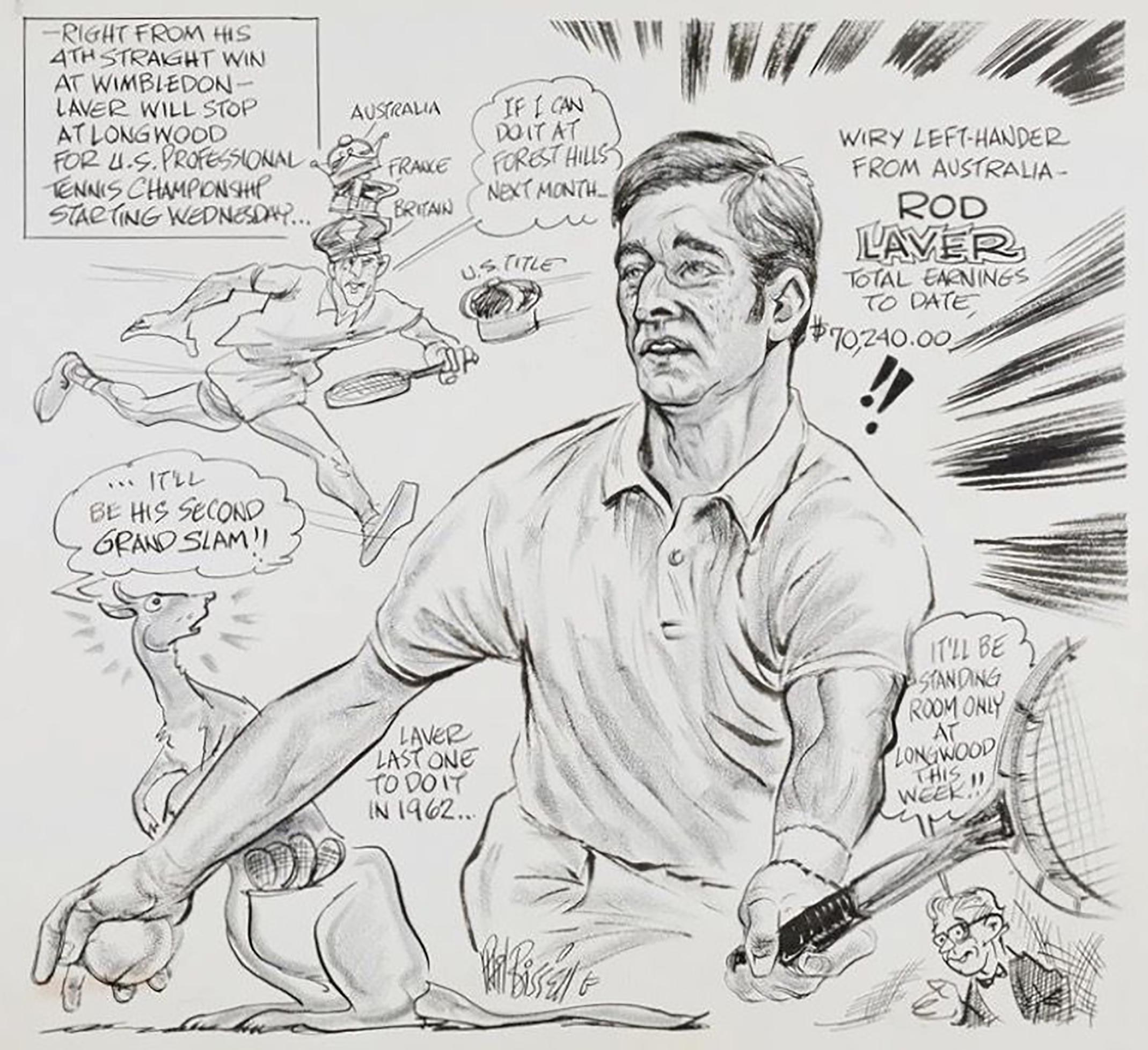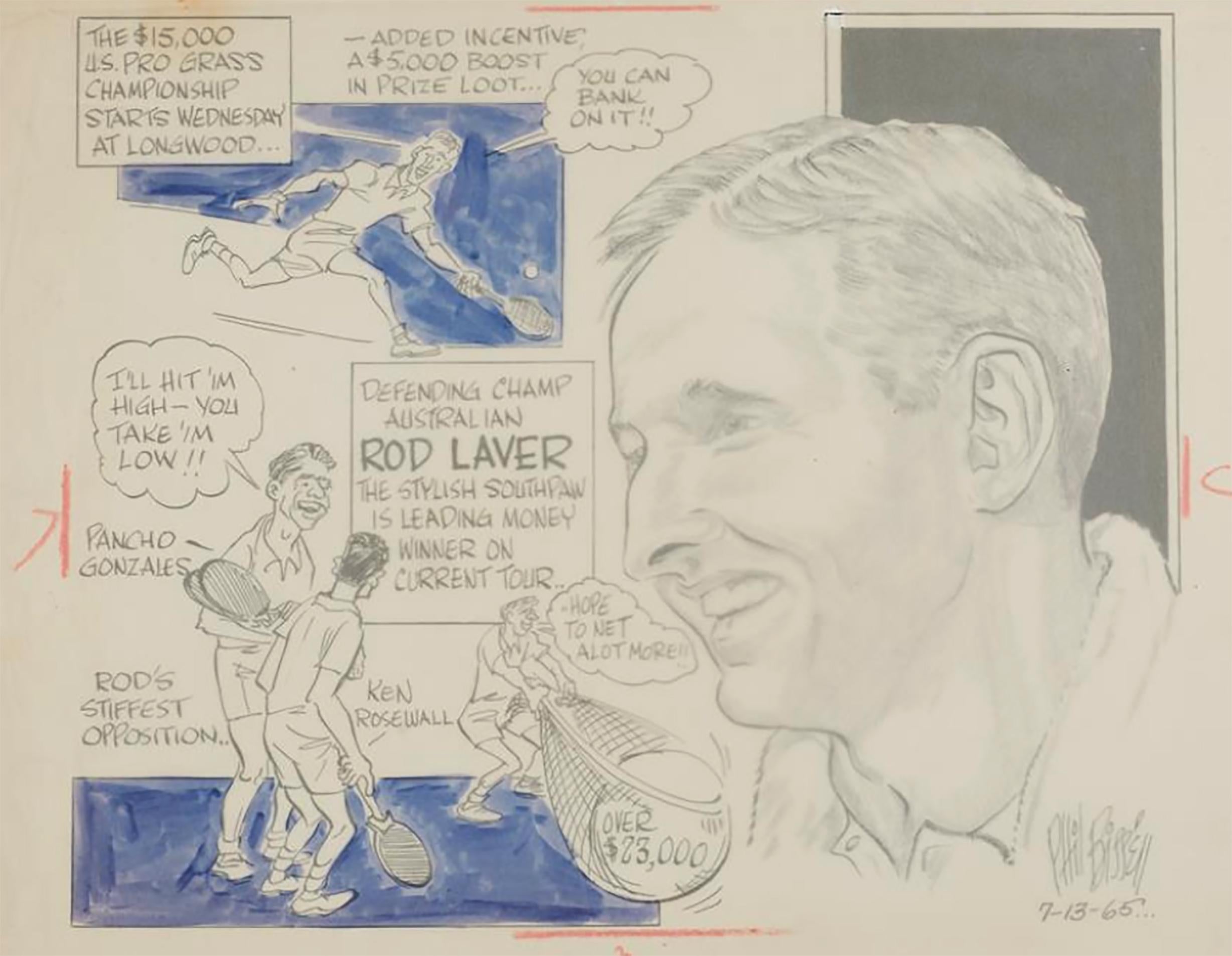Items Similar to Caricature of "Father of the Bride"
Want more images or videos?
Request additional images or videos from the seller
1 of 2
George WachsteterCaricature of "Father of the Bride"1961
1961
About the Item
Medium: Pen and Ink on Illustration Board
Signature: Signed Lower Center
On 22.00" x 15.25" illustration board with the image measuring to 14.00" x 9.50."
Caricature by George Wachsteter (1911-2004) for `Father of the Bride`, CBS-TV, with Leon Ames, Myrna Fahey, Ruth Warwick & Burt Metcalf, to promote the Nov 17, 1961 episode `Maid of Honor`. The artwork is on illustration board, as printed bears caption `Ring-a-Ding`, for the cover of the Nov 12, 1961 New York Journal-American TView Magazine. Includes original copies of the magazine. The piece comes with watercolor on paper overlay and includes color comp.
- Creator:George Wachsteter (1911 - 2004)
- Creation Year:1961
- Dimensions:Height: 14 in (35.56 cm)Width: 9.5 in (24.13 cm)
- Medium:
- Period:
- Condition:Stains in top margin, tear to overlay.
- Gallery Location:Fort Washington, PA
- Reference Number:1stDibs: LU38436225262
About the Seller
5.0
Recognized Seller
These prestigious sellers are industry leaders and represent the highest echelon for item quality and design.
Established in 1995
1stDibs seller since 2016
106 sales on 1stDibs
Typical response time: 2 hours
- ShippingRetrieving quote...Ships From: Fort Washington, PA
- Return PolicyA return for this item may be initiated within 14 days of delivery.
More From This SellerView All
- "Umbrellas of Cherbourg"By George WachsteterLocated in Fort Washington, PAMedium: Pen and Ink on Illustration Board Signature: Signed Lower Right Caricature by George Wachsteter (1911-2004) for 1964 French movie `Umbrellas of Cherbourg...Category
1960s Figurative Drawings and Watercolors
MaterialsInk, Illustration Board, Pen
- Tops from Down UnderLocated in Fort Washington, PAMedium: Pen and Ink on Illustration Board Signature: Signed Lower Center Contact for dimensions.Category
20th Century Figurative Drawings and Watercolors
MaterialsInk, Illustration Board, Pen
- Rod LaverLocated in Fort Washington, PAMedium: Pen and Ink on Illustration Board Signature: Signed Lower RightCategory
1960s Figurative Drawings and Watercolors
MaterialsInk, Illustration Board, Pen
- Can King Conquer?Located in Fort Washington, PAMedium: Pen and Ink on Illustration Board Signature: Unsigned Contact for dimensions.Category
20th Century Figurative Drawings and Watercolors
MaterialsInk, Illustration Board, Pen
- King Arthur of the CourtLocated in Fort Washington, PAMedium: Pen and Ink on Illustration Board Signature: Signed Lower Right Contact for dimensions.Category
20th Century Figurative Drawings and Watercolors
MaterialsInk, Illustration Board, Pen
- Kings- Queen of the CourtLocated in Fort Washington, PAMedium: Pen and Ink on Illustration Board Signature: Signed Upper Right Contact for dimensions.Category
20th Century Figurative Drawings and Watercolors
MaterialsInk, Illustration Board, Pen
You May Also Like
- Freya (Seated Backwards), Mixed media on grey boardBy Howard TangyeLocated in London, GBHoward Tangye (b.1948, Australia) has been an influential force in fashion for decades. Lecturing at London’s Central Saint Martins for 35 years, including 16 years as head of BA Wom...Category
2010s Contemporary Figurative Paintings
MaterialsOther Medium, Archival Paper, Handmade Paper, Pen, Felt Pen, Permanent M...
- Abstract Silhouette Hat Portraits - Female Illustrator of Golden AgeBy Jessie GillespieLocated in Miami, FL115 years after they were created, one can view these silhouettes differently than the artist’s intent. After all, the genesis of this work was an editorial illustration for Life Magazine to showcase elaborate women’s hats. They were done for a commercial assignment with a deadline, and picky editors were overseeing the final work. Today, they have a dual meaning. These charming silhouettes are abstractions as much as they are representations. Moreover, each one is a compact little gem stuffed with observational detail. Golden Age female illustrator Jesse Gillespie's mastery of technical skill, is apparent in minute details and composition. Young women, old women, pendants, necklaces, feathers, and laced vails all contribute to the works understated complexity. The identity of the subjects are revealed by small areas of exposed neck and chin. As the viewers eyes goes from left to right - all six silhouettes read as fashion hieroglyphs in a sentence with a visual rhythm and cadence. . Initialed JG lower right., Matted but not framed. Published: Life Magazine, March 17th, 1910. Provenance: Honey and Wax Bookstore ________________________________ From Wikipedia, the free encyclopedia Jessie Gillespie Willing (March 28, 1888 – August 1, 1972) was an American illustrator during the Golden Age of illustration. She was considered the foremost silhouette illustrator of her time, although she did traditional illustration as well. Willing illustrated for books and magazines including Life, The Ladies' Home Journal, Woman's Home Companion, Mother and Child, McClure's Magazine, Childhood Education, the Sunday Magazine, Association Men (the magazine of the YMCA), Farm and Fireside, Every Week, Children: The Magazine for Parents (which became Parents Magazine), and the American Magazine. She is perhaps most well known for her work for the Girl Scouts. Early life Willing was born in Brooklyn on March 28, 1888 to John Thomson Willing (August 4, 1860 – July 8, 1947)[1][2] and Charlotte Elizabeth Van Der Veer Willing (December 1, 1859 – March 4, 1930).[3] Thomson Willing was a noted illustrator and art editor. He was also well known for finding new artistic talent. Jessie Willing was the eldest of three children. Her brother Van Der Veer (November 30, 1889 – January 14, 1919), who died of pneumonia at the age of 29, was an advertising agent.[4] Her sister Elizabeth Hunnewell Willing (July 26, 1908 – August 15, 1991) was one of the first women to graduate from the Philadelphia Divinity School.[5][6] Elizabeth married the Rev. Orrin Judd, rector of St. Mary's Episcopal Church, on September 22, 1931, and was active in church work.[citation needed] The Willing family moved to the Germantown neighborhood of Philadelphia in 1901 or 1902. Jessie Willing attended the Stevens School, from which she graduated in 1905. She then went on to attend the Philadelphia Academy of Fine Arts from 1906 to 1907.[7][8] Career Willing used her middle name Gillespie as her professional surname. She also often signed her illustrations J.G.[9] The story goes that the art editor of Life magazine was in Thomson Willing's office when he was the art editor of the Associated Sunday Magazine syndicate. Thomson Willing had some of Jessie's artwork on his desk, which the Life editor saw and admired. He asked for the artist's information so that he could give her freelance work. Thomson Willing did not want to be accused of nepotism so he persuaded Jessie to use Jessie Gillespie as her professional name, which she did.[10][11] In addition to her extensive illustration work, Willing was also the editor of Heirlooms and Masterpieces from 1922 to 1931 and the art editor of Jewelers' Circular-Keystone from 1933 to 1939.[12] She specialized in jewelry publicity and advertising. In 1966 she won the Gold medal of the Printing Week Graphic Arts Exhibit in Philadelphia for her Christmas catalog for J.E. Caldwell Co., Philadelphia. Willing was a member of the Plastic Club of Philadelphia,[13] the American Institute of Graphic Arts (AIGA) and the National Arts Club of New York.[14] She was an honorary life member of the National Arts Club[15] and served on its Board of Governors from 1941-1970. In 1963, she received the Gold Medal of the National Arts Club in recognition of 32 years of selfless devotion.[15] Additionally, she was the national director of the American Institute of Graphic Arts (AIGA) from 1943 to 1946.[15] Previous to this she served as the Program Chairman of the AIGA and in that position she put together a travelling exhibit on the "history of narrative art from the first recorded picture story to the comic book of the twentieth century."[16][17] Illustrations in books With Tongue and Pen--Frederick Bair, et al. (MacMillan, 1940) Masoud the Bedouin--Alfred Post Carhart (Missionary Education Movement, 1915) The Path of the Gopatis--Zilpha Carruthers (National Dairy Council, 1926) The Schoolmaster and His Son: A Narrative of the Thirty Years War--Karl Heinrich Caspari (Lutheran Publication Society, 1917) On a Rainy Day--Dorothy Canfield Fisher and Sarah Scott Fisher (A.S. Barnes and Co., 1938) Book of Games for Home, School and Playground--William B. Forbush and Harry R Allen...Category
1910s Victorian Portrait Drawings and Watercolors
MaterialsInk, Illustration Board, Pen
- Mother and Child, Golden Age of IllustrationBy Jessie Willcox SmithLocated in Miami, FLAmerica's greatest female illustrator draws a heartwarming picture of a mother putting to bed her child. Motherly love towards their children is the artist's most iconic theme. This ...Category
Early 1900s Art Nouveau Figurative Drawings and Watercolors
MaterialsInk, Illustration Board, Pen
- Environmental Prognostication Coil Narrative "Homo Sapiens R.I.P."Located in Miami, FL"They paved paradise and put up a parking lot," Joni Mitchell said. - - Created in 1969, at the dawn of the American environmental movement, artist Richard Erdoes draws a sequential narrative in the form of a coil. From inception to destruction, it illustrates a list of things that humans are doing to destroy the world we live in. The work was commissioned for school-age humans and executed in a whimsically comic way. Yet the underlying narrative is sophisticated and foreshadows a world that could be on the brink of ecological disaster. Graphically and conceptually, this work exhibits an endless amount of creativity and Erdoes cartoony style is one to fall in love with. Signed lower right. Unframed 12.4 inches Width: 12.85 inches Height is the live area. Board is 16x22 inches. Richard Erdoes (Hungarian Erdős, German Erdös; July 7, 1912 – July 16, 2008) was an American artist, photographer, illustrator and author. Early life Erdoes was born in Frankfurt,to Maria Josefa Schrom on July 7, 1912. His father, Richárd Erdős Sr., was a Jewish Hungarian opera singer who had died a few weeks earlier in Budapest on June 9, 1912.After his birth, his mother lived with her sister, the Viennese actress Leopoldine ("Poldi") Sangora,He described himself as "equal parts Austrian, Hungarian and German, as well as equal parts Catholic, Protestant and Jew..."[4] Career He was a student at the Berlin Academy of Art in 1933, when Adolf Hitler came to power. He was involved in a small underground paper where he published anti-Hitler political cartoons which attracted the attention of the Nazi regime. He fled Germany with a price on his head. Back in Vienna, he continued his training at the Kunstgewerbeschule, now the University of Applied Arts, Vienna.[5] He also wrote and illustrated children's books and worked as a caricaturist for Tag and Stunde, anti-Nazi newspapers. After the Anschluss of Austria in 1938 he fled again, first to Paris, where he studied at the Academie de la Grande Chaumiere, and then London, England before journeying to the United States. He married his first wife, fellow artist Elsie Schulhof (d. xxxx) in London, shortly before their arrival in New York City. In New York City, Erdoes enjoyed a long career as a commercial artist, and was known for his highly detailed, whimsical drawings. He created illustrations for such magazines as Stage, Fortune, Pageant, Gourmet, Harper's Bazaar, Sports Illustrated, The New York Times, Time, National Geographic and Life Magazine, where he met his second wife, Jean Sternbergh (d. 1995) who was an art director there. The couple married in 1951 and had three children.[6] Erdoes also illustrated many children's books. An assignment for Life in 1967 took Erdoes to the Pine Ridge Indian Reservation for the first time, and marked the beginning of the work for which he would be best known. Erdoes was fascinated by Native American culture, outraged at the conditions on the reservation and deeply moved by the Civil Rights Movement that was raging at the time. He wrote histories, collections of Native American stories...Category
1960s American Realist Landscape Drawings and Watercolors
MaterialsInk, Gouache, Illustration Board
- 19th C. Newspaper Illustration of Hiram H. Hobbs, Foreman of the Grand Jury 1898Located in Soquel, CAHistorical late 19th century portrait of Hiram H. Hobbs, Foreman of the Grand Jury of San Francisco y Richard Langtry Partington (American, ...Category
1890s American Impressionist Portrait Drawings and Watercolors
MaterialsIndia Ink, Illustration Board
- "Surrealist Composition, " Ink on Board Drawing by Marvin HillBy Marvin HillLocated in Milwaukee, WI"Surrealist Composition" is an original ink on fourply museum board by Marvin Hil. It depicts a man balancing on a point over a faceless man and hovering above pyramids. 15 1/4" x ...Category
1980s Surrealist Figurative Drawings and Watercolors
MaterialsInk, Illustration Board





